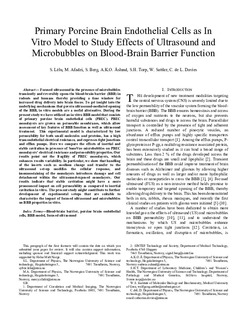| dc.contributor.author | Lelu, Sylvie | |
| dc.contributor.author | Afadzi, Mercy | |
| dc.contributor.author | Berg, Sigrid | |
| dc.contributor.author | Åslund, Andreas | |
| dc.contributor.author | Torp, Sverre Helge | |
| dc.contributor.author | Sattler, Wolfgang | |
| dc.contributor.author | Davies, Ruth Catharina de Lange | |
| dc.date.accessioned | 2017-10-25T06:46:25Z | |
| dc.date.available | 2017-10-25T06:46:25Z | |
| dc.date.created | 2017-01-18T13:07:18Z | |
| dc.date.issued | 2017 | |
| dc.identifier.citation | IEEE Transactions on Ultrasonics, Ferroelectrics and Frequency Control. 2017, 64 (1), 281-290. | nb_NO |
| dc.identifier.issn | 0885-3010 | |
| dc.identifier.uri | http://hdl.handle.net/11250/2461976 | |
| dc.description.abstract | Focused ultrasound in the presence of microbubbles transiently and reversibly opens the blood-brain barrier (BBB) in rodents and humans thereby providing a time window for increased drug delivery into brain tissue. To get insight into the underlying mechanisms that govern ultrasound-mediated opening of the BBB, in vitro models are a useful alternative. During the present study we have utilized an in vitro BBB model that consists of primary porcine brain endothelial cells (PBEC). PBEC monolayers are grown on permeable membranes, which allow assessment of key features of BBB function as well as ultrasound treatment. This experimental model is characterized by low permeability for both small molecules and proteins, has a high transendothelial electrical resistance, and expresses tight junctions and efflux pumps. Here we compare the effects of inertial and stable cavitation in presence of SonoVue microbubbles on PBEC monolayers’ electrical resistance and permeability properties. Our results point out the fragility of PBEC monolayers, which enhances results variability. In particular, we show that handling of the inserts such as medium change and transfer to the ultrasound set-up modifies the cellular response, and immunostaining of the monolayers introduces damage and cell detachment within the ultrasound-exposed monolayers. Our results indicate that stable cavitation might have a more pronounced impact on cell permeability as compared to inertial cavitation in vitro. The present study might contribute to further development of experimental setups that are suitable to characterize the impact of focused ultrasound and microbubbles on BBB properties in vitro. | nb_NO |
| dc.language.iso | eng | nb_NO |
| dc.publisher | Institute of Electrical and Electronics Engineers (IEEE) | nb_NO |
| dc.title | Primary Porcine Brain Endothelial Cells as In Vitro Model to Study Effects of Ultrasound and Microbubbles on Blood-Brain Barrier Function | nb_NO |
| dc.type | Journal article | nb_NO |
| dc.type | Peer reviewed | nb_NO |
| dc.description.version | acceptedVersion | nb_NO |
| dc.source.pagenumber | 281-290 | nb_NO |
| dc.source.volume | 64 | nb_NO |
| dc.source.journal | IEEE Transactions on Ultrasonics, Ferroelectrics and Frequency Control | nb_NO |
| dc.source.issue | 1 | nb_NO |
| dc.identifier.doi | 10.1109/TUFFC.2016.2597004 | |
| dc.identifier.cristin | 1430805 | |
| dc.relation.project | Norges forskningsråd: 240316 | nb_NO |
| dc.relation.project | Norges forskningsråd: 220005 | nb_NO |
| dc.description.localcode | © 2016 IEEE. Personal use of this material is permitted. Permission from IEEE must be obtained for all other uses, in any current or future media, including reprinting/republishing this material for advertising or promotional purposes, creating new collective works, for resale or redistribution to servers or lists, or reuse of any copyrighted component of this work in other works. | nb_NO |
| cristin.unitcode | 194,66,20,0 | |
| cristin.unitcode | 194,65,25,0 | |
| cristin.unitcode | 194,65,15,0 | |
| cristin.unitname | Institutt for fysikk | |
| cristin.unitname | Institutt for sirkulasjon og bildediagnostikk | |
| cristin.unitname | Institutt for klinisk og molekylær medisin | |
| cristin.ispublished | true | |
| cristin.fulltext | postprint | |
| cristin.qualitycode | 1 | |
